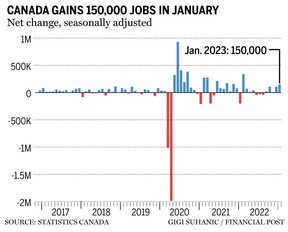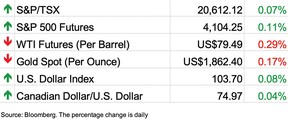Blockbuster data have markets raising rate hike odds — but not so fast

Reviews and recommendations are unbiased and products are independently selected. Postmedia may earn an affiliate commission from purchases made through links on this page.
Article content

Good Morning,
Advertisement 2
Article content
Article content
“This is not what BoC governor Tiff Macklem wanted to see,” wrote mortgage analysis Robert McLister after Friday’s job numbers.
The data was certainly a shocker. The 150,000 jobs Canada gained in January were not only 10 times economists’ expectations, but were also more per capita than the 517,000 jobs gained in the United States that rattled markets the week before, McLister said.
One way to gauge the health of this report is to look at the employment to population ratio, said BMO chief economist Douglas Porter — ” Canada’s employment rate of 62.5 per cent matches the strongest read since the days before the Global Financial Crisis.”
Economists tend to treat Canada’s notoriously volatile jobs data with caution, but even so this did not look like the cooling economy the Bank of Canada is aiming for in its battle against inflation.
Advertisement 3
Article content
“The labour market is sending precisely zero signs of economic stress. For the Bank of Canada, the strong report must make them at least a tad nervous about their freshly-minted pause,” said Porter.
The Bank of Canada has raised interest rates to 4.5 per cent over the past 11 months to tame inflation, which, at 6.3 per cent in December, is still well above its target of two per cent. On Jan. 25, the Bank said it would hold off further moves while it assesses how the economy is faring.
Markets reacted quickly to Friday’s “blowout” job numbers, with Canada’s 5-year yield rising 11 basis points. McLister said in his MortgageLogic.news that rate cuts this year were now completely off the table, according to overnight index swap data, and markets were pricing in a seven in 10 chance of another hike by summer.
Advertisement 4
Article content
The rally in yields is disappointing for anyone hoping for lower borrowing rates, said McLister. Mortgage markets were getting comfortable with the idea that fourth-quarter rate cuts would usher in a new central bank cycle that would bring rates closer to normalcy.
“Now, with yields surging on North American’s jobs jubilee, rate watchers are second-guessing their outlooks,” he said.
Still, McLister says there are several reasons not to panic about the job numbers.
First is the decline in wage growth, that the report also revealed. Average hourly wages rose 4.5 per cent from the year before, down from a 4.8 per cent year-over-year increase in December.
“Cooling wage pressures were the only factor in today’s report that augurs well for further easing of inflation,” Desjardins economist Marc Desormeaux said in a note.
Advertisement 5
Article content
McLister said few expect the Bank of Canada to risk its credibility and end the pause just on a “few inflation-unfriendly data points,” and economists agree.
“The Bank of Canada’s conditional pause on interest rates was likely done in part so that policymakers didn’t feel the need to respond to any single data print, no matter how strong, but rather assess how the economy is faring over the course of a few months, said Andrew Grantham, an economist for CIBC which maintains its forecast that the central bank will hold rates steady for the remainder of the year.
Canada’s next inflation reading out Feb. 21 will pull more weight with the central bank than job numbers.
Moreover, the slowdown central banks are trying to engineer to cool inflation could still happen, and according to some indicators probably will.
Advertisement 6
Article content
McLister points to the widening U.S. Treasuries yield curve inversion. When long rates fall below short-term yields it has historically been a good guide that recession is coming.
“Investors clearly believe the U.S. economy is headed for trouble,” said McLister. “And if the U.S. is in trouble, Canada is in trouble.”
CIBC chief economist Avery Shenfeld is also watching corporate bond spreads, which widen ahead of a recession on credit risk concerns, and the performance of the stock market, which tends to weaken before a downturn on earnings fears.
As of last week there was a 31 per cent chance of a U.S. recession six months from now, based on those indicators, he said in a note.
“That’s a new high for this expansion, suggesting that we’re clearly not out of the woods. And a U.S. recession in most cases is sufficient to generate a Canadian downturn,” he said.
Advertisement 7
Article content
_____________________________________________________________
Was this newsletter forwarded to you? Sign up here to get it delivered to your inbox.
_____________________________________________________________________


Canada’s job market once again smashed expectations by adding 150,000 jobs in January, 10 times what economists had forecast. This was the fifth consecutive monthly gain and the unemployment rate held steady at 5 per cent.
“It was a blowout report for the Canadian labour market,” wrote TD Economics’ James Orlando after the data came out Feb. 10 “The 150k jobs gain is one thing, but the fact that gains were concentrated in full-time jobs in the private sector, alongside people working more hours, makes this an even more impressive report.”
Advertisement 8
Article content

- The standing committee on industry and technology meet regarding the mandate of the minister of industry, science and technology. Industry, Science and Technology Minister Francois-Philippe Champagne appears
- Filomena Tassi, minister responsible for FedDev Ontario, will make an announcement in support of rural economic development
- WestJet announces new U.S. routes and domestic connectivity from Edmonton International Airport
- Today’s Data: Construction investment
- Earnings: Dye & Durham, Algoma Steel, H&R REIT
___________________________________________________


_______________________________________________________


Thinking of opening an RESP for your child or grandchild? FP Answers walks you through setting up an registered education savings plan and looks at the three main investing options: cash, bonds and stocks. Find out more
____________________________________________________
Today’s Posthaste was written by Pamela Heaven, @pamheaven, with additional reporting from The Canadian Press, Thomson Reuters and Bloomberg.
Have a story idea, pitch, embargoed report, or a suggestion for this newsletter? Email us at posthaste@postmedia.com, or hit reply to send us a note.






